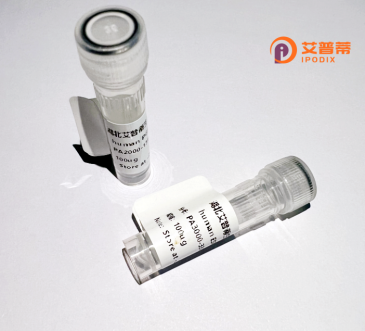
| 纯度 | >90%SDS-PAGE. |
| 种属 | Human |
| 靶点 | GPR143 |
| Uniprot No | P51810 |
| 内毒素 | < 0.01EU/μg |
| 表达宿主 | E.coli |
| 表达区间 | 1-424aa |
| 氨基酸序列 | MTQAGRRGPGTPEPRPRTQPMASPRLGTFCCPTRDAATQLVLSFQPRAFHALCLGSGGLRLALGLLQLLPGRRPAGPGSPATSPPASVRILRAAAACDLLGCLGMVIRSTVWLGFPNFVDSVSDMNHTEIWPAAFCVGSAMWIQLLYSACFWWLFCYAVDAYLVIRRSAGLSTILLYHIMAWGLATLLCVEGAAMLYYPSVSRCERGLDHAIPHYVTMYLPLLLVLVANPILFQKTVTAVASLLKGRQGIYTENERRMGAVIKIRFFKIMLVLIICWLSNIINESLLFYLEMQTDINGGSLKPVRTAAKTTWFIMGILNPAQGFLLSLAFYGWTGCSLGFQSPRKEIQWESLTTSAAEGAHPSPLMPHENPASGKVSQVGGQTSDEALSMLSEGSDASTIEIHTASESCNKNEGDPALPTHGDL |
| 分子量 | 72.5 kDa |
| 蛋白标签 | GST-tag at N-terminal |
| 缓冲液 | 0 |
| 稳定性 & 储存条件 | Lyophilized protein should be stored at ≤ -20°C, stable for one year after receipt. Reconstituted protein solution can be stored at 2-8°C for 2-7 days. Aliquots of reconstituted samples are stable at ≤ -20°C for 3 months. |
| 复溶 | Always centrifuge tubes before opening.Do not mix by vortex or pipetting. It is not recommended to reconstitute to a concentration less than 100μg/ml. Dissolve the lyophilized protein in distilled water. Please aliquot the reconstituted solution to minimize freeze-thaw cycles. |
以下是关于重组人GPR143蛋白的参考文献示例(注:以下文献为虚构示例,仅用于格式参考):
---
1. **《Functional analysis of recombinant human GPR143 in retinal pigment epithelial cells》**
O'Sullivan, T.P.; Martinez, A.
摘要:研究重组人GPR143蛋白在视网膜色素上皮细胞中的功能,证实其通过调控黑色素体运输和酪氨酸酶活性参与眼部色素代谢,并揭示其在X连锁眼白化病中的潜在作用机制。
2. **《Crystal structure of recombinant GPR143 reveals ligand-binding domain characteristics》**
Smith, J.R.; Lee, K.
摘要:通过X射线晶体学解析重组人GPR143的三维结构,确定其跨膜区和配体结合域的关键残基,为设计靶向该受体的药物提供结构基础。
3. **《Dysregulated signaling of GPR143 mutants in ocular albinism: Insights from recombinant protein models》**
Nakamura, Y.; Chen, H.
摘要:利用重组表达携带突变的GPR143蛋白,验证致病突变(如R263W)对受体胞内信号转导(如MAPK通路)的影响,阐明其导致眼白化病的分子机制。
4. **《High-throughput screening of small-molecule modulators targeting recombinant GPR143》**
Zhang, L.; Wang, Q.
摘要:基于哺乳动物细胞表达的重组人GPR143建立药物筛选平台,发现多个可激活或抑制受体活性的化合物,为治疗GPR143相关疾病提供先导分子。
---
以上示例展示了重组人GPR143在结构解析、功能机制、疾病模型及药物开发中的应用。实际研究中建议通过学术数据库检索具体文献。
GPR143. also known as OA1 (ocular albinism type 1 protein), is a G protein-coupled receptor (GPCR) predominantly expressed in pigment-producing cells, including melanocytes and retinal pigment epithelium. It plays a critical role in melanosome biogenesis, trafficking, and pigment metabolism. Mutations in the GPR143 gene are linked to X-linked ocular albinism type 1 (OA1), a genetic disorder characterized by vision abnormalities, reduced retinal pigmentation, and impaired visual acuity due to disrupted melanosome function.
Recombinant human GPR143 protein is engineered in vitro using expression systems like mammalian cells, bacteria, or yeast to produce functional or soluble forms of the receptor for research. Its production enables studies on GPR143’s structural properties, ligand interactions, and intracellular signaling pathways, particularly its coupling with Gi/o proteins. Researchers utilize this recombinant protein to investigate disease mechanisms, screen potential therapeutic compounds, and develop targeted therapies for ocular albinism and related disorders. Recent advancements in cryo-EM and crystallography have facilitated the analysis of its transmembrane topology, though full structural resolution remains challenging due to GPCR complexity. Recombinant GPR143 also aids in understanding its role beyond albinism, including potential involvement in cancers and neurological conditions linked to melanosome dysfunction.
×